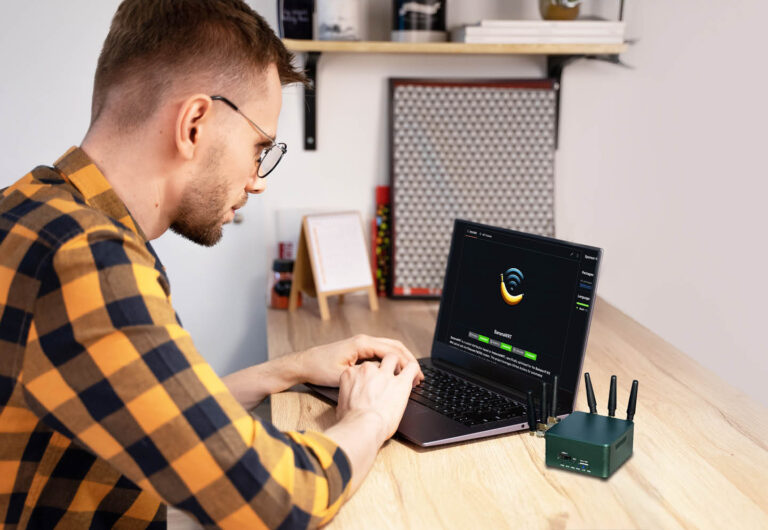Going Bananas for 5G: Recipe for a FOSS Network

The demand for fast, reliable mobile connections is skyrocketing as smartphones, tablets, smart TVs and IoT devices flood the market. Older networks struggle to keep up, leading to slowdowns and instability. Enter 5G, powered by open source innovation and offering higher performance, ultra-low latency, and better management of multiple devices, all with the flexibility and transparency FOSS brings to the table.
This article is both the story of, and the recipe for, how I built my own powerful, flexible 5G network using FOSS: you can too!
Next-Level Connectivity: Your 5G Journey Starts Here
This guide focuses on bringing advanced 5G connectivity to individual users. The solution makes this powerful technology accessible to:
- Technology Enthusiasts – Individuals seeking to implement and experiment with cutting-edge connectivity solutions in personal environments
- Remote Professionals – Home-based workers requiring reliable, high-performance connections for video conferencing and cloud-based applications
- Interactive Media Users – Gamers and streaming enthusiasts who depend on low-latency, high-bandwidth connections for optimal experiences
- Smart Home Integrators – Users developing comprehensive IoT ecosystems with multiple connected devices requiring stable network management
- Independent Developers – DIY technologists looking for cost-effective alternatives to commercial 5G products while maintaining performance standards
This approach democratizes 5G technology, making it accessible at a significantly reduced cost point while delivering exceptional performance for personal and small-scale implementations.
Why 5G Has Become Essential
One of the main advantages of 5G is ultra-low latency, which significantly improves real-time applications such as online gaming, telemedicine, and remote work. 5G also supports a higher number of connected devices than older networks, ensuring stable performance even in crowded environments.
Its versatility makes it ideal for a wide range of applications, including drones, augmented reality, industrial automation, and smart cities. Additionally, 5G efficiently combines different frequency bands, using lower frequencies for wide coverage and higher frequencies for ultra-fast speeds. This flexibility allows 5G to adapt to both urban and rural areas.
The Role of Open Source in 5G
Open source technology plays a crucial role in making 5G more flexible, transparent, and customizable. Unlike proprietary solutions, open source platforms offer:
- Freedom of choice, avoiding dependence on a single vendor
- A global developer community that contributes to bug fixes and new features
- Improved security and stability, as open source code is transparent and frequently updated
In the 5G world, this means users can optimize their networks without relying on expensive updates from a single provider.
Banana Pi R3 Mini: A 5G Router FOSS Recipe
The Banana Pi R3 Mini is a compact yet powerful networking device. It features 2.5 GbE ports for high-speed wired connections, Wi-Fi 6 for improved wireless performance, and hardware acceleration to optimize network efficiency.
Fibocom FM350: A Plug-and-Play 5G Module with BananaWRT
For seamless 5G connectivity, the Fibocom FM350 module is an excellent choice, especially when paired with BananaWRT, a user-friendly open source firmware.
The FM350 is plug and play with BananaWRT. Simply insert it into the M.2 key-b slot, configure your APN, and you are ready to go. No complicated driver installations are needed. This module supports multiple 5G bands, making it compatible with different mobile operators worldwide.
BananaWRT: Open Source Firmware for 5G Networking
BananaWRT, based on ImmortalWRT, is designed to provide an optimized and stable firmware for the Banana Pi R3 Mini. It offers:
- Frequent updates through continuous development
- Built-in support for 5G, simplifying setup
- An intuitive web interface, making it easy to configure APN settings, firewalls, and network parameters
- Modular customization, allowing users to install additional packages based on their specific needs
How to Build Your Open Source 5G Network, Step By Step
You can get a Banana Pi R3 Mini from an official retailer at a reasonable cost. Then follow these steps:
- Install the Fibocom FM350 module, securing it in the appropriate M.2 key-b slot.
- Download BananaWRT from the official repository.
- Configure the APN settings to connect to your mobile operator’s 5G network.
- Customize your router settings, including Wi-Fi, firewall, and VPN configurations.
Practical Applications and Benefits
An open source 5G network using Banana Pi R3 Mini serves the following needs:
- Better remote work with faster connections and reduced latency for video calls and cloud services
- Enhanced gaming and streaming with more stable and responsive network performance
- Smarter home automation, allowing for quick and reliable communication between IoT devices
- Industrial applications, supporting low-latency robotics, smart factories, and automated processes
Bringing It All Together: My 5G Journey with FOSS
The transition to 5G isn’t just about faster speeds: it’s about unlocking network flexibility and true customization. With the Banana Pi R3 Mini, Fibocom FM350, and BananaWRT, I found what appears to be a great combo to build a powerful, configurable 5G router that meets my needs without relying on proprietary solutions. Whether you’re a tech enthusiast, IT professional, or curious tinkerer, this FOSS-powered setup gives you the tools to take full control of your network infrastructure with transparency and security. I’m thrilled to share this journey, and I hope it inspires you to explore the endless possibilities of building your own open 5G network!
